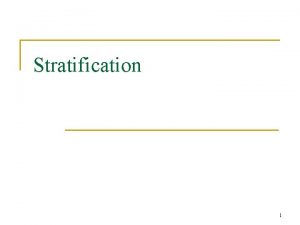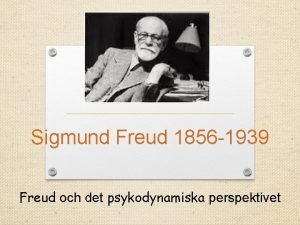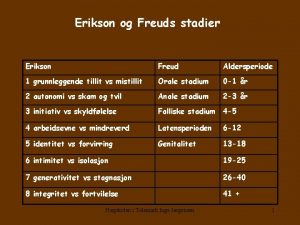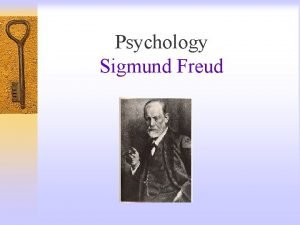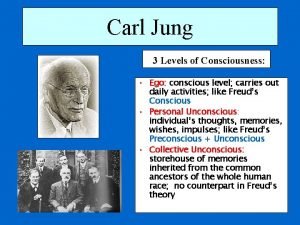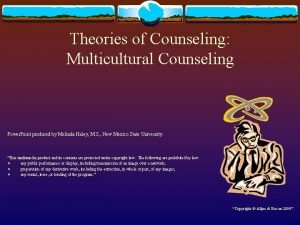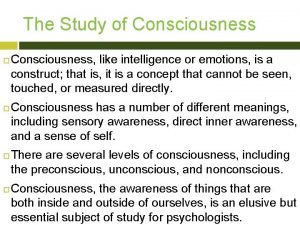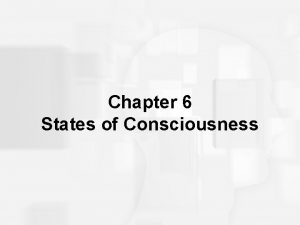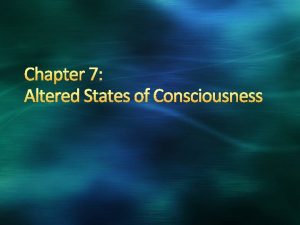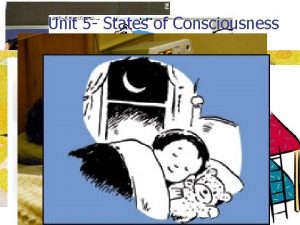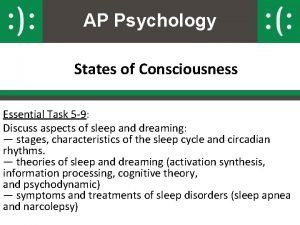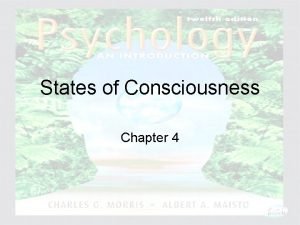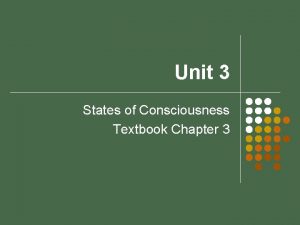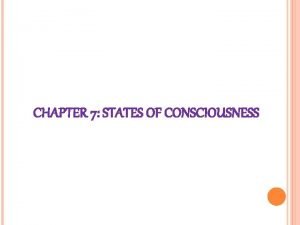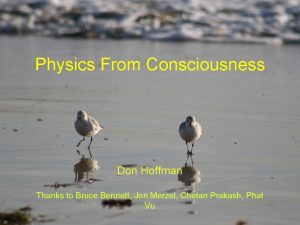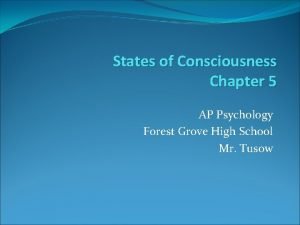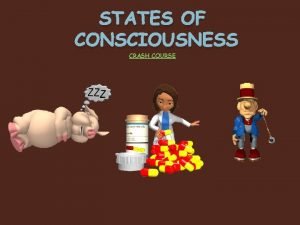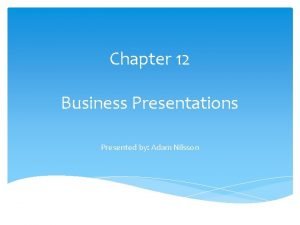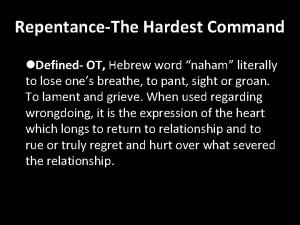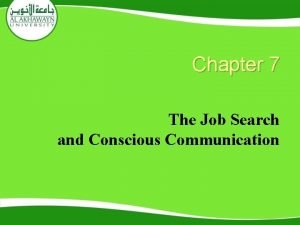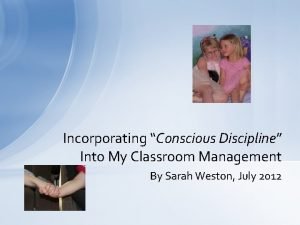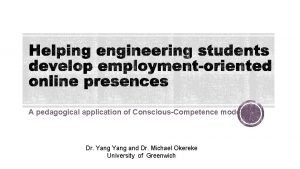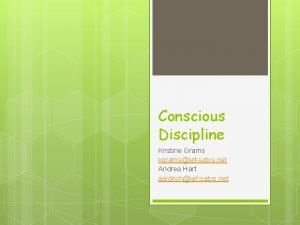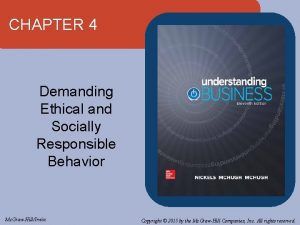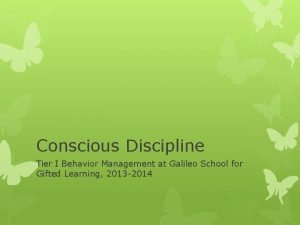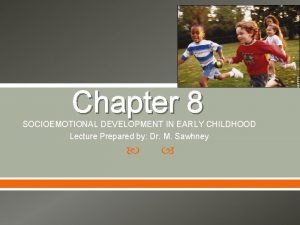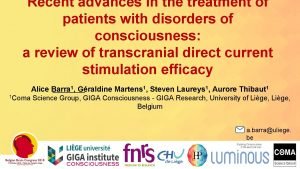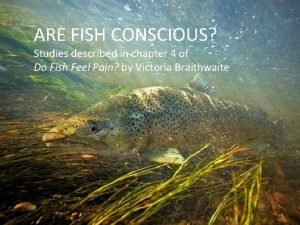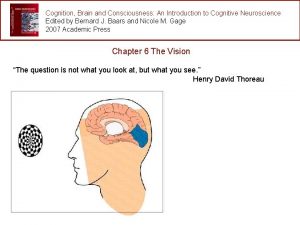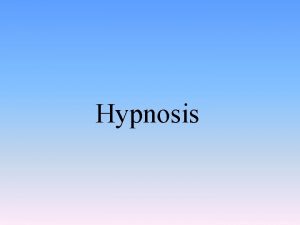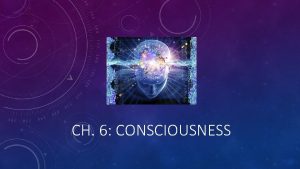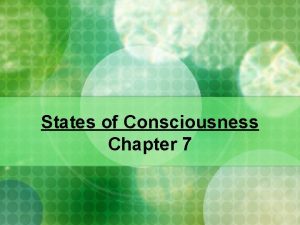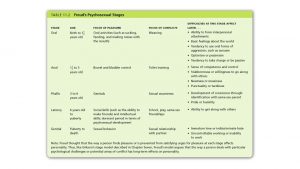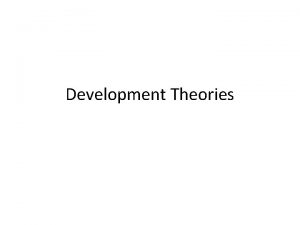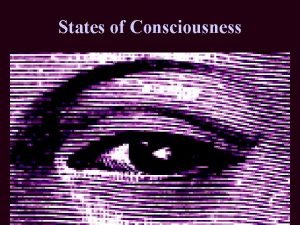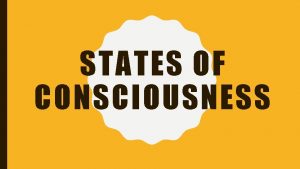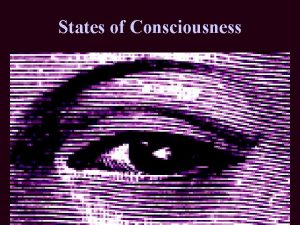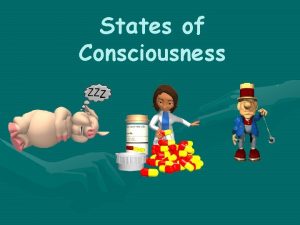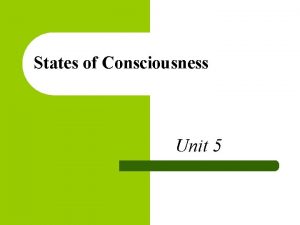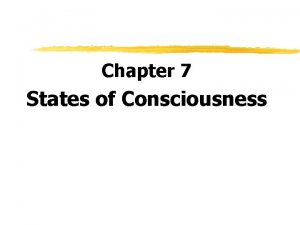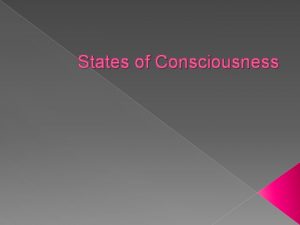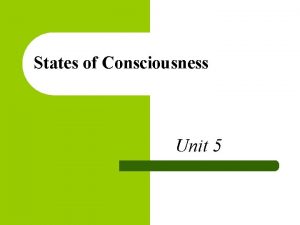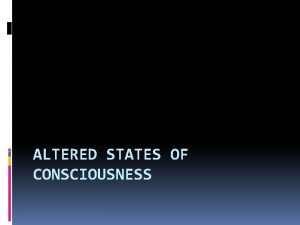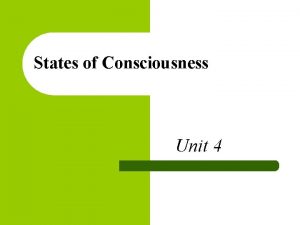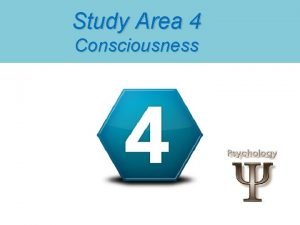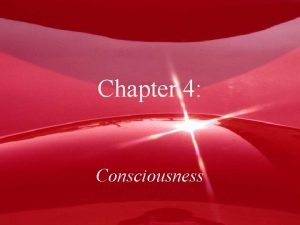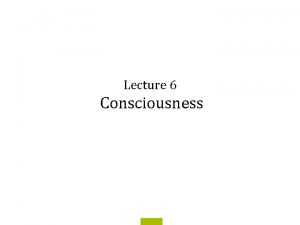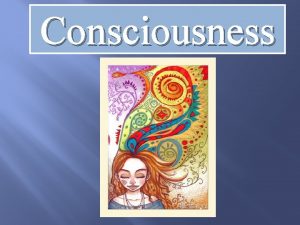States of Consciousness Freuds Levels of Consciousness Conscious












































- Slides: 44

States of Consciousness

Freud’s Levels of Consciousness • Conscious Level: perceptions, thought • Preconscious Level: memories, stored knowledge • Unconscious Level: selfish needs, violent motives, immoral urges, fears, irrational wishes, shameful experiences, unacceptable desires

Consciousness • Awareness of oneself and one’s environment, Both inside and out. • Selective attention- focusing on a particular stimulus.

Sleep and Sleep Deficit

Sleep Deprivation Effects • Decreases efficiency of immune system functioning • Safety and accident issues • Contributes to hypertension, impaired concentration, irritability, etc.

Sleep Deprivation (National Transportation Safety Board, 1995)

Module 20: Sleep, Dreams, and Body Rhythms Why We Sleep

Hypothalamus • Sleep control center in the brain • Monitors changes in light or dark in the environment • Changes levels of hormones in the body

Melatonin • A hormone that helps regulate daily biological rhythms • Linked to the sleep-wake cycle • Melatonin level increases during the night and decreases with exposure to morning light

Reasons for Sleep • Two primary reasons: – Preservation: keep us protected from the dangers of the night – Restoration: recuperate from the wear and tear of the day

Module 20: Sleep, Dreams, and Body Rhythms Sleep Stages, REM, and Dreaming: The Stages of Sleep

Electroencephalograph (EEG) • A machine that amplifies and records waves of electrical activity that sweep across the brain’s surface • Electrodes are placed on the person’s scalp to measure the waves • Used as a means to measure the stages of sleep

EEG

Stage 1 Sleep • Breathing is slowed. • Brain waves become irregular. • It is easy to wake the person, who will insist they are not asleep. • Person will report they have dreamlike sensations, such as falling.

Stage 1

Stages of Sleep

Stage 1

Stage 2 Sleep • Brain wave cycle slows. • EEG spindles (small brain wave bursts) develop. • First time through stage 2 last about 20 minutes.

Stage 2

Stages 3 and 4 Sleep • Increase in delta waves (large and slow waves per second) • First time through stage 4 is about 30 minutes and is where one gets rejuvenated

Stage 3

Stage 4

Module 20: Sleep, Dreams, and Body Rhythms Sleep Stages, REM, and Dreaming: REM Sleep

REM Sleep • Stages 1 - 4 considered N-REM (non. REM sleep) • Rapid eye movement (REM Sleep) as eyes move quickly back and forth • Most dreaming occurs in REM sleep

REM Sleep

Paradoxical Sleep • During REM sleep brain wave patterns are similar to when a person is awake • Pulse and breathing quickens. • REM sleep is sometimes called paradoxical sleep as one’s physiology is close to that of being awake but the brainstem blocks all muscle movement

Typical Night’s Sleep

Stage 4/REM Changes

Sleep Changes through Life

Module 20: Sleep, Dreams, and Body Rhythms Sleep Stages, REM, and Dreaming: Why Do We Dream?

Information-Processing Theory • Dreams serve an important memoryrelated function by sorting and sifting through the day’s experiences • Research suggests REM sleep helps memory storage.

Physiological Function Theory • Neural activity during REM sleep provides periodic stimulation of the brain.

Activation-Synthesis Theory • Dreams are the mind’s attempt to make sense of random neural firings in the brain as one sleeps.

Module 20: Sleep, Dreams, and Body Rhythms Sleep Disorders and Sleep Problems: Insomnia

Insomnia • Recurring problems falling asleep or staying asleep • Sleeping pills tend to inhibit or suppress REM sleep; worsen the problem • Alcohol suppresses REM sleep; also worsens the problem • Studies show most people overestimate how long it took them to get to sleep

Module 20: Sleep, Dreams, and Body Rhythms Sleep Disorders and Sleep Problems: Sleep Apnea

Sleep Apnea • A sleep disorder characterized by temporary cessations of breathing during sleep and consequent momentary reawakenings. • Tend to be loud snorers • Continuous Positive Airway Pressure machine

Module 20: Sleep, Dreams, and Body Rhythms Sleep Disorders and Sleep Problems: Narcolepsy

Narcolepsy • A sleep disorder characterized by uncontrollable sleep attacks • Person goes directly into REM sleep • Nervous system getting aroused tends to trigger the sleep attack

Module 20: Sleep, Dreams, and Body Rhythms Sleep Disorders and Sleep Problems: Other Sleep Problems

Somnambulism • Formal name for sleepwalking • Starts in the deep stages of N-REM sleep • Person can walk or talk but remembers nothing of the experience

Night Terrors • Sleep disorder characterized by high arousal and appearance of being terrified • Happens during stage 4 sleep; mostly children • The children seldom remember the event.

Other Sleep Disorders • Teeth grinding • Bed wetting • Sudden jerk of a body part occurring during stage 1 sleep – Everyone has occasional episodes

The End
 Type of social mobility
Type of social mobility Carly's therapist asks her to simply
Carly's therapist asks her to simply Falliska fasen
Falliska fasen Freud persönlichkeitsmodell
Freud persönlichkeitsmodell Saeb is a high school senior
Saeb is a high school senior Freud stadier
Freud stadier Freud iceberg
Freud iceberg Erikson teoria de la personalidad
Erikson teoria de la personalidad The self carl jung
The self carl jung Multicultural counseling ppt
Multicultural counseling ppt Levels of consciousness examples
Levels of consciousness examples Feelings in a dream chapter 7
Feelings in a dream chapter 7 7 states of consciousness
7 states of consciousness Lesson quiz 7-1 altered states of consciousness
Lesson quiz 7-1 altered states of consciousness Chapter 7 altered states of consciousness
Chapter 7 altered states of consciousness Unit 5 states of consciousness answers
Unit 5 states of consciousness answers Altered state of consciousness psychology
Altered state of consciousness psychology Ap psychology states of consciousness
Ap psychology states of consciousness 3 states of consciousness
3 states of consciousness Chapter 7 states of consciousness
Chapter 7 states of consciousness Unit 5 states of consciousness
Unit 5 states of consciousness States of consciousness ap psychology
States of consciousness ap psychology Crash course states of consciousness
Crash course states of consciousness Costas level of question
Costas level of question Southern states vs northern states
Southern states vs northern states Tyranny
Tyranny There were 11
There were 11 Good organization and conscious repetition
Good organization and conscious repetition Naham-ot meaning
Naham-ot meaning The good job search and conscious communication
The good job search and conscious communication Conscious discipline breathing techniques
Conscious discipline breathing techniques Conscious proprioception
Conscious proprioception What is conscious discipline
What is conscious discipline Howell 1982 conscious competence model
Howell 1982 conscious competence model Conscious discipline composure
Conscious discipline composure Conscious proprioception
Conscious proprioception Demanding ethical and socially responsible behavior
Demanding ethical and socially responsible behavior Conscious discipline brain model
Conscious discipline brain model 700 000
700 000 Minimally conscious state
Minimally conscious state Ethical decision making metric
Ethical decision making metric Conscious bias
Conscious bias Which intellectual trait includes conscious understanding
Which intellectual trait includes conscious understanding Are fish conscious
Are fish conscious Consciousness
Consciousness
